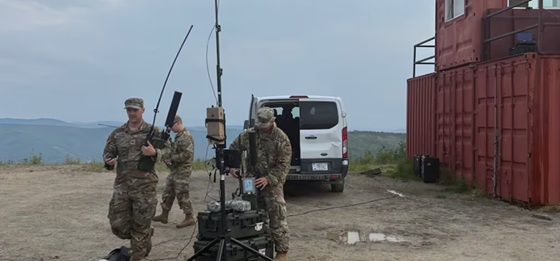The U.S. Department of Defense (DOD), through its Defense Innovation Unit (DIU), conducted a drone testing event in late June 2025 near Fort Wainwright, Alaska, aiming to replicate the electronic warfare (EW) conditions observed in Ukraine’s ongoing conflict. The trial involved five commercial companies testing drones and radio prototypes against simulated EW threats, such as jamming of navigation and command-and-control systems. This initiative reflects the Pentagon’s broader push to enhance its unmanned aerial system (UAS) capabilities by exposing commercial systems to real-world battlefield conditions, a response to the critical role drones have played in Ukraine. The testing highlighted both the potential and the challenges of integrating small, commercial firms into the DOD’s supply chain, as well as the need for more accessible and realistic testing environments to accelerate drone development and deployment.
Key Details
1. Testing Environment and Objectives:
– The DIU selected a remote range in Alaska to simulate Ukraine-like conditions, where drones face intense EW threats, including GPS jamming and communication disruptions. Alaska was chosen for its minimal civilian infrastructure, reducing risks of signal interference, and its long summer daylight hours, enabling extended testing.
– The trial focused on assessing whether the drones could maintain navigation, acquire targets, and operate effectively under simulated EW conditions. Most systems tested were prototypes, marking their first exposure to field conditions outside controlled lab settings.
2. Participants and Performance:
– Five companies participated, though only AV (formerly AeroVironment) and Dragoon were named in related reports. Two Ukrainian firms, paired with U.S. software companies, were involved but tested separately due to operational constraints in Ukraine.
– Initial results showed mixed performance. Many drones struggled with jamming and immature technology, with issues like failing to maintain targets or navigate routes. However, companies made progress by iterating solutions during the four-day event, aligning with DIU’s goal of fostering rapid adaptation.
3. Challenges in Testing Infrastructure:
– The DOD faces significant hurdles in providing suitable testing environments. Most U.S. ranges restrict active EW testing due to policies from the Federal Aviation Administration (FAA) and Federal Communications Commission (FCC), which aim to protect GPS and communication signals for civilian use.
– Advanced ranges like White Sands Missile Range are oversubscribed, making access difficult for smaller programs or commercial firms. Additionally, the EW equipment used in Alaska, primarily from the Army’s 11th Airborne Division, was outdated, designed for older threats and less effective against modern, software-defined systems.
4. Strategic Initiatives:
– The DIU launched Project G.I., a prize challenge to identify “ready-now” UAS for small military units operating in disrupted environments. Selected companies will participate in live demonstrations, with potential funding or contracts for further development.
– The Range Strike Group, a new DIU effort, is tasked with addressing testing access issues by identifying policy hurdles and proposing solutions to streamline approvals for EW testing.
– The Pentagon is also implementing broader policy reforms, such as Defense Secretary Pete Hegseth’s July 2025 directive to treat small UAS (under 55 pounds) as consumable commodities, reducing bureaucratic oversight and encouraging their use in combat.
5. Broader Context:
– The urgency of these efforts stems from the U.S. lagging behind adversaries like China and Russia in small UAS production. China’s DJI dominates global drone sales, while U.S. laws prohibit military purchases of Chinese drones, highlighting the need for a robust domestic industry.
– Ukraine’s rapid iteration and fielding of drones in combat provide a model for the U.S., which seeks to emulate this agility. However, logistical and political barriers have prevented testing in Ukraine itself, leading to the choice of Alaska as a domestic alternative.
Analysis
1. Strategic Implications:
– The Alaska trials underscore the Pentagon’s recognition that modern warfare increasingly relies on affordable, expendable drones, as demonstrated in Ukraine. The DOD’s push to replicate these conditions signals a shift toward prioritizing rapid innovation over traditional, slow acquisition processes.
– By treating small UAS as consumables, the Pentagon aims to reduce the financial and bureaucratic burdens that deter soldiers from using drones, potentially increasing their adoption across units. This aligns with Hegseth’s directive to equip every squad with low-cost drones by 2026.
2. Challenges and Risks:
– The mixed performance of the tested drones highlights a gap in the U.S. drone industrial base, particularly in developing systems resilient to advanced EW threats. The reliance on outdated EW equipment during testing further complicates assessments of system maturity.
– The lack of an acquisition partner for the DIU’s Artemis project, which aims to field low-cost, long-range attack drones, illustrates persistent bureaucratic resistance within the DOD. This “valley of death” between prototype and production remains a significant barrier.
– Policy restrictions on EW testing and limited range availability could delay progress, especially for small firms lacking resources to navigate complex FAA and FCC approvals.
3. Opportunities:
– Initiatives like Project G.I. and the Range Strike Group could democratize access to testing, fostering innovation among smaller companies and diversifying the DOD’s supplier base.
– The Pentagon’s investment in domestic drone production, backed by hundreds of millions in funding, could stimulate the U.S. industrial base, reducing reliance on foreign suppliers and enhancing national security.
– Lessons from Ukraine, where daily field testing drives rapid iteration, suggest that embedding engineers with warfighters and increasing testing frequency could accelerate U.S. drone development.
Recommendations
1. Expand Testing Infrastructure:
– The DOD should prioritize developing dedicated EW testing ranges with modern equipment to simulate advanced threats. Streamlining FAA and FCC approvals, as suggested by the Range Strike Group, could reduce delays and make testing more accessible.
2. Foster Public-Private Collaboration:
– The DIU should strengthen partnerships with commercial firms through programs like Project G.I., offering clear pathways to production contracts. Incentives like advance purchase commitments could encourage investment in domestic drone manufacturing.
3. Integrate Lessons from Ukraine:
– While testing in Ukraine is not feasible, the DOD could facilitate controlled exchanges with Ukrainian operators to share insights on EW resilience and rapid iteration, potentially through virtual simulations or limited on-site collaborations.
4. Address Bureaucratic Barriers:
– The DOD should identify and empower acquisition partners for projects like Artemis to bridge the gap between prototyping and fielding. Hegseth’s reforms, such as decentralizing procurement authority to brigade-level officers, should be implemented swiftly to ensure momentum.
Conclusion
The Pentagon’s Alaska drone trials represent a critical step toward adapting to the evolving demands of modern warfare, where small, affordable UAS are pivotal. By seeking Ukraine-like conditions, the DOD acknowledges the need for realistic testing environments to prepare drones for contested battlefields. However, challenges in technology maturity, testing infrastructure, and bureaucratic inertia highlight the complexity of this transition. Strategic initiatives like Project G.I., the Range Strike Group, and policy reforms offer promising avenues to close these gaps, but sustained investment and collaboration will be essential to achieve drone dominance by 2027, as envisioned by the Pentagon.
Discover more from Defence Talks | Defense News Hub, Military Updates, Security Insights
Subscribe to get the latest posts sent to your email.





